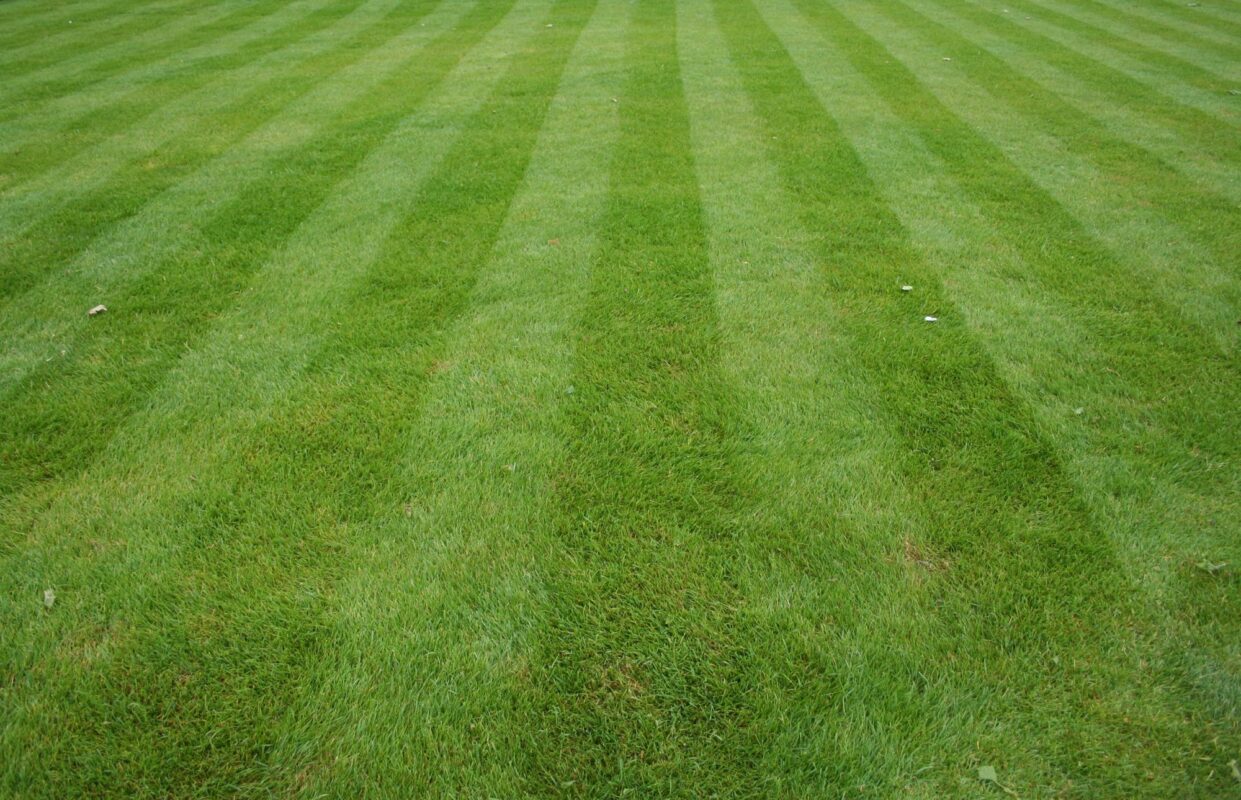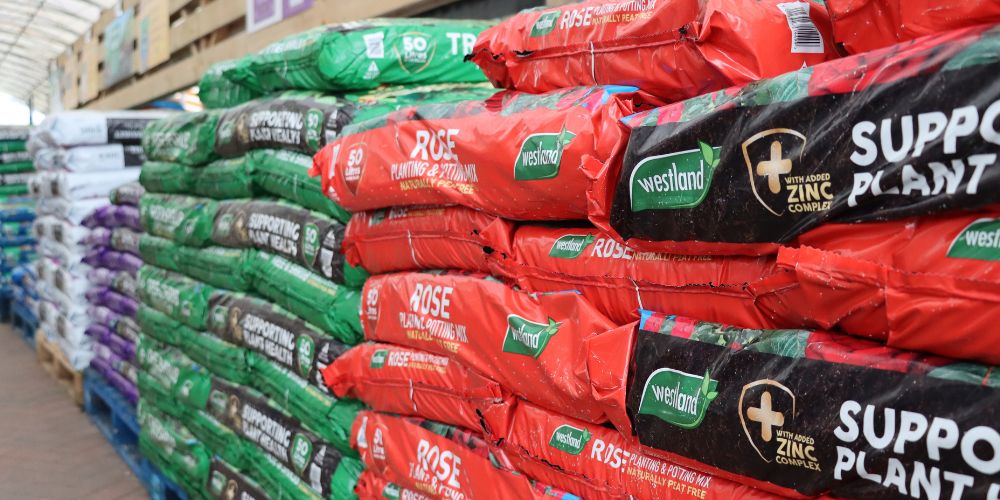CREATING THE PERFECT LAWN
SOIL PREPARATION
The lawn is usually the focal point of the garden. If it is in poor condition, the whole garden looks a mess. When making a new lawn, careful attention must be paid to site preparation, drainage and the selection of turf or seed. Carelessness at this stage is likely to result in a second rate lawn.
Correct soil preparation is important for long-term success. Prepare a few weeks in advance of sowing or turfing by eliminating any weeds, rubbish and large stones.
Dig or rotovate and level the top 15-25cm, trying not to bring the subsoil to the top. If the soil is wet, of a clay nature, or liable to water logging, drainage may be necessary.
Two weeks before sowing or turfing, apply a general fertiliser at the rate shown on the product, and rake it in. A 2.5cm deep dressing of peat or peat substitute should be raked into the top 4cm of soil to retain moisture and prevent the seed or turf drying out as it grows. Firm the soil by treading the surface in both directions, taking care not to compact it. Finish off by raking level and removing any medium-large stones or rubbish. It’s best to prepare an area of 15-25cm larger than required to enable the grass or turf to be cut to a firm edge when fully established.
SHAPE & SITE
Good design requires an attractive shape, but one that is easy to maintain. A square or rectangle is the traditional shape but a simple irregular outline is more attractive and easier to mow. It’s best to avoid small or fussy curves and awkward corners. The lawn does not have to be uniformly flat – a gentle slope of about 1 in 80 is satisfactory. All parts of the lawn should receive at least some direct sunlight – dense shade will lead to problems.
Narrow verges of less than a metre wide between hedges and paths are best avoided as these make mowing difficult. Stepping stones set in the lawn will prevent excessive wear along well-trodden routes. Make sure that the top of each stone is below the level of the soil surface.
Once the grass is 4-5cm high it can be mown with the mower blades set high.
SOWING
The best time to sow is early to mid-September when the soil is still warm and the chance of a water shortage is declining. April sowing is often successful but watering will be necessary if the summer is dry. Watering can be tricky on a newly-sown lawn.
Work out the amount of seed required allowing 50g per m² to allow for seed lost to birds. For hardwearing lawns suitable for regular children’s games choose a utility grade mixture with ryegrass. For general use as an outdoor living area, select a utility grade without ryegrass and for a quality lawn select a luxury mixture containing Fescues and Bents.
To ensure even distribution of the seed, first mark out your prepared area into 1 metre squares. Weigh out the amount required for the first square metre and scatter the seed evenly over the area marked out. Repeat for each square. Stretching cotton or netting over the area will help protect the seed from birds. In dry conditions the area might require light watering.
Once the grass is 4-5cm high it can be mown with the mower blades set high.
TURFING
Turf can be laid at almost any time as long as the soil is not very dry, waterlogged or frozen. the best months are from March to June, and from September to November. When measuring the area to be turfed – allow an overlap of 15cm (6in) so that the lawn can be cut to a firm edge once it has established. Order your turf well in advance for delivery on or near a specific date, allowing for weather conditions that may interfere with the cutting of the turf by the supplier.
Make sure the soil preparation is completed by the delivery date as turf must be laid out as soon as possible to prevent damage. Should laying be delayed, unroll the turf on a path, drive or other area away from the turfing site, keeping it moist to prevent long term damage.
Start from an outside edge and work off a board placed on newly-laid turf, working systematically over the area, carefully unrolling each turf and laying them closely in a brick pattern. Use the back of a spade to gently but firmly beat the turf flat so that the roots are in close contact with the soil. If there are any high or low spots, remove or add soil as necessary.
TRIMMING
Use a half-moon tool for cutting the edges of newly-laid turf and the edges of existing lawns. Vertical trimming, or edging, is necessary at regular intervals to maintain a neat appearance. Clippings should be removed from beds and borders after edging to prevent bits of grass from rooting in the soil. There is a choice between long-handled shears and mechanical edgers – ordinary hand shears are only suitable for very small lawns.
The need for vertical trimming can be reduced by preparing a mowing edge. This is a grass-free strip of earth all around the lawn. The gap between the lawn and a fence or wall must be wide enough to allow free movement of the mower.
MAINTAINING THE PERFECT LAWN
SOIL PREPARATION
The lawn is usually the focal point of the garden. If it is in poor condition, the whole garden looks a mess. When making a new lawn, careful attention must be paid to site preparation, drainage and the selection of turf or seed. Carelessness at this stage is likely to result in a second rate lawn.
Correct soil preparation is important for long-term success. Prepare a few weeks in advance of sowing or turfing by eliminating any weeds, rubbish and large stones.
Dig or rotovate and level the top 15-25cm, trying not to bring the subsoil to the top. If the soil is wet, of a clay nature, or liable to water logging, drainage may be necessary.
Two weeks before sowing or turfing, apply a general fertiliser at the rate shown on the product, and rake it in. A 2.5cm deep dressing of peat or peat substitute should be raked into the top 4cm of soil to retain moisture and prevent the seed or turf drying out as it grows. Firm the soil by treading the surface in both directions, taking care not to compact it. Finish off by raking level and removing any medium-large stones or rubbish. It’s best to prepare an area of 15-25cm larger than required to enable the grass or turf to be cut to a firm edge when fully established.
SHAPE & SITE
Good design requires an attractive shape, but one that is easy to maintain. A square or rectangle is the traditional shape but a simple irregular outline is more attractive and easier to mow. It’s best to avoid small or fussy curves and awkward corners. The lawn does not have to be uniformly flat – a gentle slope of about 1 in 80 is satisfactory. All parts of the lawn should receive at least some direct sunlight – dense shade will lead to problems.
Narrow verges of less than a metre wide between hedges and paths are best avoided as these make mowing difficult. Stepping stones set in the lawn will prevent excessive wear along well-trodden routes. Make sure that the top of each stone is below the level of the soil surface.
Once the grass is 4-5cm high it can be mown with the mower blades set high.
SOWING
The best time to sow is early to mid-September when the soil is still warm and the chance of a water shortage is declining. April sowing is often successful but watering will be necessary if the summer is dry. Watering can be tricky on a newly-sown lawn.
Work out the amount of seed required allowing 50g per m² to allow for seed lost to birds. For hardwearing lawns suitable for regular children’s games choose a utility grade mixture with ryegrass. For general use as an outdoor living area, select a utility grade without ryegrass and for a quality lawn select a luxury mixture containing Fescues and Bents.
To ensure even distribution of the seed, first mark out your prepared area into 1 metre squares. Weigh out the amount required for the first square metre and scatter the seed evenly over the area marked out. Repeat for each square. Stretching cotton or netting over the area will help protect the seed from birds. In dry conditions the area might require light watering.
Once the grass is 4-5cm high it can be mown with the mower blades set high.
TURFING
Turf can be laid at almost any time as long as the soil is not very dry, waterlogged or frozen. the best months are from March to June, and from September to November. When measuring the area to be turfed – allow an overlap of 15cm (6in) so that the lawn can be cut to a firm edge once it has established. Order your turf well in advance for delivery on or near a specific date, allowing for weather conditions that may interfere with the cutting of the turf by the supplier.
Make sure the soil preparation is completed by the delivery date as turf must be laid out as soon as possible to prevent damage. Should laying be delayed, unroll the turf on a path, drive or other area away from the turfing site, keeping it moist to prevent long term damage.
Start from an outside edge and work off a board placed on newly-laid turf, working systematically over the area, carefully unrolling each turf and laying them closely in a brick pattern. Use the back of a spade to gently but firmly beat the turf flat so that the roots are in close contact with the soil. If there are any high or low spots, remove or add soil as necessary.
TRIMMING
Use a half-moon tool for cutting the edges of newly-laid turf and the edges of existing lawns. Vertical trimming, or edging, is necessary at regular intervals to maintain a neat appearance. Clippings should be removed from beds and borders after edging to prevent bits of grass from rooting in the soil. There is a choice between long-handled shears and mechanical edgers – ordinary hand shears are only suitable for very small lawns.
The need for vertical trimming can be reduced by preparing a mowing edge. This is a grass-free strip of earth all around the lawn. The gap between the lawn and a fence or wall must be wide enough to allow free movement of the mower.
LAWN MAINTENANCE BY MONTH
JANUARY
Little to do on the established lawn this month. Never walk on the lawn when it is frosty as the grass will be damaged or killed, and when the surface is soft or wet as this can lead to compaction and thereby root damage.
This is a good time to have the mower overhauled and to make sure that the other lawn tools are ready for use in the spring. Turfing is possible during a fine spell.
FEBRUARY
In mild districts the lawn care season may begin with the appearance of worm casts: scatter them with a besom when they are dry. Do not be tempted to mow the lawn before March arrives. Finish turfing this month. If planning to sow seed, begin soil preparation at the end of the month.
MARCH
As soon as the grass has started to grow and the weather and ground conditions are suitable, rake the lawn to remove leaves and surface rubbish. The first cut should be on the highest setting and should be done on a dry day. Two cuts this month will be sufficient. Apply a moss killer if necessary. Neaten untidy edges with a half-moon.
APRIL
Feed with a fertiliser or a combined fertiliser/weedkiller towards the end of the month. If Lawn Sand is used, make sure that it is spread evenly and that the dead moss is raked up 10-14 days later. Mow often enough to stop the grass getting too long but do not cut lower than 20-30mm.
MAY
Continue to mow at least once a week and spike and feed if not already done in April. This is normally the best month for weed killing with either a selective weedkiller or Lawn Sand. The soil is usually moist in May but a prolonged dry spell can occur. If this happens, water before signs of distress appear and always irrigate copiously.
JUNE
Cutting twice a week is necessary when the soil is moist. If there is a long dry spell, raise the height of the cut and do not use the grass box. Further applications of a selective weedkiller may be required to kill persistent weeds such as clover. Trim the edges regularly and be prepared to water if there is a dry spell.
JULY
Continue to mow at the summer height and mow alternately at right angles to the previous cut. If clover, pearlwort or yarrow appear use a good selective weedkiller containing 2 or 3 active ingredients.
AUGUST
The same as for July: do not let the lawn dry out completely.
SEPTEMBER
The autumn programme begins this month. Increase the interval between each mowing and raise the height of the cut. Worms may become active and casts need to be swept away. Use an autumn lawn fertiliser if the lawn is pale and thin. Carry out repairs. The correct routine is to scarify first, then spike compacted areas and finally top dress. If disease patches appear use a systemic fungicide. This is the best month for sowing a new lawn.
OCTOBER
Regular mowing ceases this month and for these cuts the mower blades should be on the highest setting. Apply an autumn fertiliser and carry out the autumn routine tasks if not tackled last month. Brush up fallen leaves.
NOVEMBER
Sweep up any leaves as they fall as these may seriously damage the grass. Provided that the weather is neither frosty nor wet mowing may continue early in the month. Continue to brush away worm casts.
DECEMBER
Keep off the lawn when wet or frozen but otherwise the only job is to brush away leaves and debris.








